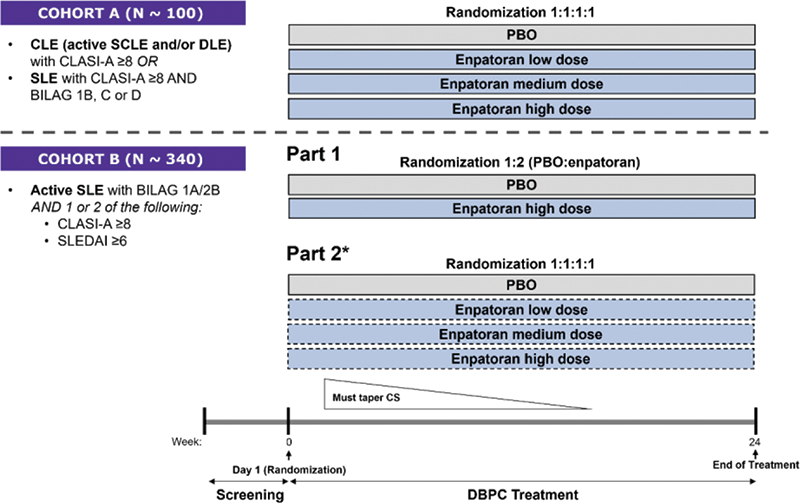

Background: Enpatoran is a potent selective dual inhibitor of toll-like receptor (TLR) 7 and TLR8, aberrant activation of which may be involved in systemic lupus erythematosus (SLE) pathogenesis and glucocorticoid resistance. 1,2,3 Enpatoran suppressed disease development in lupus mouse models, improving survival and reducing proteinuria, autoantibodies, and the interferon (IFN) gene signature. 1 In healthy participants and patients hospitalized with COVID-19 pneumonia, enpatoran was well tolerated and demonstrated effective TLR7/8 engagement. 4 Enpatoran is potentially glucocorticoid sparing and may help avoid the detrimental effects of long-term corticosteroid use in SLE management. 5,6
Objectives: To evaluate the glucocorticoid-sparing effect of enpatoran and design a basket trial to assess its efficacy and safety in patients with SLE and/or cutaneous lupus erythematosus (CLE).
Methods: Cytokine concentrations and gene expression changes were measured in stimulated human peripheral blood mononuclear cells (PBMCs) from healthy donors after treatment with dexamethasone, TLR7/8 inhibitor, or both. A Phase II, basket design proof-of-concept, dose-finding study in patients with SLE and/or CLE (WILLOW) was designed.
Results: In healthy donor PBMCs, synergy was observed between TLR7/8 inhibitor and dexamethasone. Combination treatment inhibited cytokine release (IL-6) with greater potency than either treatment alone and reduced the expression of nuclear factor-kappa B and IFN-regulated genes. WILLOW is a Phase II, basket proof-of-concept, dose-finding, randomized, double-blind, placebo (PBO)-controlled 24-week study with two cohorts (NCT05162586,
WILLOW study design.
Cohort A and Cohort B Part 1 will start in parallel.
*Part 2 will be initiated after a pre-specified number of patients are enrolled in Part 1; enpatoran doses in Part 2 may be adapted to improve dose finding (dashed boxes).
BILAG, British Isles Lupus Assessment Group; CLASI-A, Cutaneous Lupus Erythematosus Disease Area and Severity Index-A; CLE, cutaneous lupus erythematosus; CS, corticosteroid; DBPC, double-blind placebo-controlled; DLE, discoid lupus erythematosus; PBO, placebo; SCLE, Subacute cutaneous lupus erythematosus; SLE, systemic lupus erythematosus; SLEDAI, Systemic Lupus Erythematosus Disease Activity Index.

Conclusion: Enpatoran is a novel TLR7/8 inhibitor and may enable glucocorticoid dose reduction in patients with SLE and CLE. The WILLOW study incorporates multiple novel elements including a basket design and evaluation of glucocorticoid-sparing.
REFERENCES:
[1]Vlach, et al. J Pharmacol Exp Ther. 2021;376:397–409;
[2]Northcott, et al. Lancet Rheumatol. 2021;5:e357–e370;
[3]Guiducci, et al. Nature. 2010;465:937–941;
[4]Port, et al. Pharmacol Res Perspect. 2021;9:e00842;
[5]Thamer, et al. J Rheumatol. 2009;36:560–564;
[6]Ruiz-Irastorza, et al. Rheumatology. 2012;51:1145–1153.
Acknowledgements: This study was sponsored by the healthcare business of Merck KGaA, Darmstadt, Germany (CrossRef Funder ID: 10.13039/100009945), who funded medical writing support by Bioscript Stirling Ltd.
Disclosure of Interests: Eric F. Morand: None declared, Andrew Bender Shareholder of: Shares in Merck KGaA, Employee of: EMD Serono Research & Development institute (an affiliate of Merck KGaA), Aditee Deshpande Employee of: EMD Serono Research & Development institute (an affiliate of Merck KGaA), Bharat Vaidyanathan Employee of: EMD Serono Research & Development institute (an affiliate of Merck KGaA), cristina vazquez mateo Employee of: EMD Serono Research & Development institute (an affiliate of Merck KGaA), Melinda Przetak Employee of: EMD Serono Research & Development institute (an affiliate of Merck KGaA), Flavie Moreau Employee of: EMD Serono Research & Development institute (an affiliate of Merck KGaA), Mukhy Khursheed Employee of: Merck Serono Ltd (an affiliate of Merck KGaA), Sanjeev Roy Employee of: Ares Trading SA (an affiliate of Merck KGaA), David Pearson Consultant of: Biogen Inc.